Meet A Man With
Eight Hundred Banks
DORIS ANN KRUPINSKI, HOBBIES, March 1955
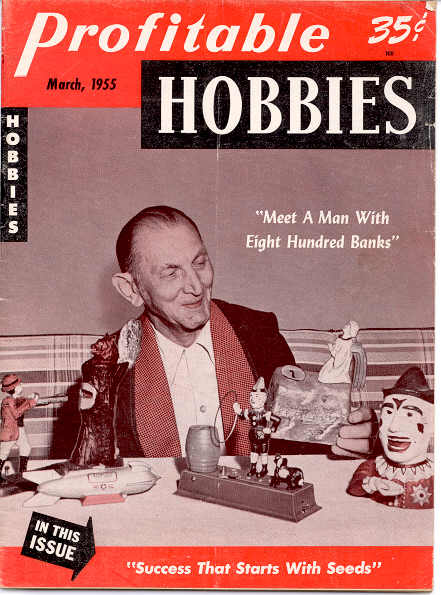
Imagine
owning nearly a thousand banks yet not being a
millionaire. That's the case with a
Milwaukee man,
but he's had a million dollars worth of fun
from his toy bank collection.
JOHN JOHANNSEN of Milwaukee, Wisconsin, has money in nearly 800 banks. In fact, he has
several thousand dollars in his banks. And yet, if he withdrew the money from every one of
them, it would only amount to a small pile of pennies.
It is the banks themselves that are worth several thousand dollars, for Johannsen is a toy
bank collector. He recommends the hobby as a source of fun and profit to everyone,
regardless of age, as long as they are "young at heart."
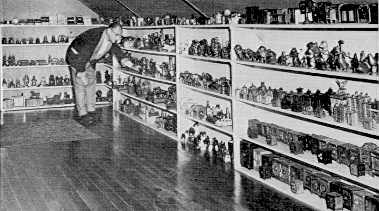
JOHN JOHANNSEN with a part of his bank
collection, which fills the upper floor of his home.
The banks are placed on the shelves according to type. Johannsen keeps a record
of each bank
that tells how much it cost, where it was purchased, the dates on which it was
last cleaned,
and other pertinent facts.
Many of the banks in Johannsen's collection are the old mechanical banks which provided
such a pleasant way of saving money a couple of generations back. A penny inserted in the
slot of any one of these banks produces amusing and sometimes noisy results.
The William Tell bank, for instance, uses a real cap, which explodes noisily when William
Tell fires a penny at an apple on his son's head. If the penny hits the apple, a window in
the iron tower at the rear opens, and the penny is deposited through it. If it misses, as
it sometimes does, you have the fun of shooting again.
In a variation of this, called Teddy and the Bear, Teddy Roosevelt fires a penny into a
slot in a tree stump, causing a brown bear to pop out of the stump.
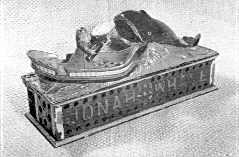
THIS IS THE POPULAR JONAH and the Whale bank.
Jonah, safe
in a little boat, feeds the coin, instead of himself, to the whale.
WHILE THESE old mechanical banks were supposedly to encourage children to save money, many
of them have themes which only adults can appreciate. The "Tammany" bank is a
portly politician with outstretched hand, who takes a coin in his palm, flips it into his
pocket, nods his head in thanks, and extends the hand again.
The Reclining Chinese holds a hand of cards against his breast. As he takes a coin with
one hand, he shows the royal flush which he holds in the other.
More truly for the amusement of children is the Eagle and Eaglets bank. This one contains
a bellows in the base which causes the two baby birds to chirp when their mother feeds
them a coin.
In addition to the mechanical banks, Johannsen's collection contains many which are termed
"semi-mechanical." This category includes such banks as miniature automobiles
and railroad cars, whose moving parts have nothing to do with the insertion of the coin.
Many register banks are also classed as semi-mechanical.
By far the greatest percentage of the collection consists of still banks, ranging in size
from the Sunday School bank, which is about as big as a candy mint, to a "combination
safe" which is a cubic foot in size. These still banks come in a variety of shapes:
figures, houses, mail boxes, animals, famous buildings, and many others. Figures are about
the hardest to come by.
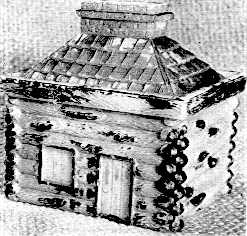
THIS PORCELAIN LOG CABIN BANK, dating back to
about 1793, once held tea,
which had to be shaken out of the coin slot in the chimney before the container
could be used as a bank.
TO BE a successful bank collector, says Johannsen, it is necessary to be a specialist. If
you try to make banks just one of the many collections, you will not become familiar
enough with them to know what fair prices are - and you'll find yourself paying too much
for each item.
If you make banks your main hobby, you will concentrate your energies on becoming expert
on the subject - and this expertness soon has an effect on the amount of profit you make.
Johannsen gives this advice out of his own experience. For many years before he became a
bank collector, he scattered his shots in the field of collecting.
"From the time I was a boy in Germany," he says, "I collected anything I
could get my hands on. Much of it would be thrown away by my parents; I'd retrieve it, and
they would throw it away again.
"When I got older, I used to haunt antique shops, buying anything that took my fancy
- and just about everything did. My wife used to call a lot of it 'Junk.' She didn't much
trust my judgement."
White-haired, twinkle-eyed Mrs. Johannsen adds with a good-natured sigh, "He just
couldn't leave antique shops alone!"
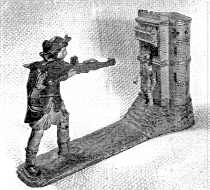
THE WILLIAM TELL BANK uses a real cap, which
goes off noisily when the coin is
shot into the window just behind Tell's son's head. Don't ask why Mr. Tell is
using a
gun instead of a bow and arrow.
As a result of all this, the Johannsen home itself eventually came to look like an antique
shop. Glassware, china, coins, stamps, dolls, playing cards, steins, were all stirred into
an indiscriminate collection that had no form or direction.
There was a handful of banks among the other things, but until a warm August afternoon in
1937, the banks held no more and no less interest for Johannsen than the other items he
had collected.
Then, on Sunday, August 4, 1937, Johannsen went to look at some items another antique
collector had for sale, and was fascinated by five mechanical banks the man was offering.
Undaunted by the fact that the collector would only sell them as a group, along with
fifty-two still banks, he bought the whole lot - and had the beginning of his present
collection.
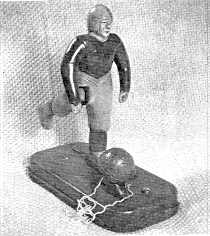
THIS IS JOHNANNSEN'S "BIG FLOP" — a
toy which he purchased believing it to be
a bank. When he discovered it was merely a mechanical toy, he removed the
operating lever and altered it so that it required insertion of a coin to work.
(Slot
which once held the lever can be seen at the rear of the base.) While it is not
really a bank, Johannsen likes to have it around as a constant reminder to
investigate what he is getting before he pays for it.
ONCE JOHANNSEN decided to specialize in toy banks, he disposed of most of the other things
he had collected and set about becoming an expert.
He dismantled the mechanical banks, piece by piece, cleaned, adjusted, and oiled them, and
thus became familiar with the working mechanics of each. He still does this whenever he
acquires a new bank, and twice a year thereafter. As a result, every item in his
collection is in top condition, a prime factor when reckoning value.
Some banks must be adjusted very precisely, or they will be damaged when used. The 'Spise
A Mule bank, for example, is often found in broken condition because of the low adjustment
tolerance.
"A bank which has been repaired or repainted, or is not in the original mechanical
condition , loses value," says Johannsen. "Sometimes you meet a collector who
has decided that the dull iron and chipped paint of his banks need brightening - and he
has painstakingly repainted them in the modern enamels. By doing so, he has reduced the
value of his collection by a third or more."
It is not always great age which determines the value of a bank, but rather the rarity.
Many of the older mechanical banks, dating back to 1870 or so, were made of such sturdy
cast iron, and sold in such great quantities, that large numbers of them still survive.
Among these are the Tammany, Cabin, and Eagle banks.
In contrast, banks of the 1880-1890 period, being often of more fragile materials, are
hard to find, and bring correspondingly higher prices.
Rarest of all are the single specimen banks, which are samples of designs that never
reached the production stage. A bronze model of a bank patented but never manufactured was
sold to a Milwaukee dealer for $600 recently. He in turn asked $750 for it!
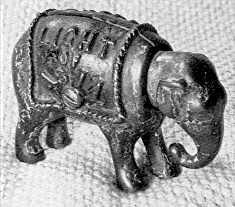
THE LIGHT OF ASIA BANK, valued at $150, nods
its head in thanks when a
coin is inserted in the slot on its back. This is an example of a bank now worth
much more than Johannsen paid for it.
JOHANNSEN, WHO collects toy bank patent papers as well as the banks themselves, finds that
a great many banks were designed and patented, but never made. Since the toy banks had to
please the parents who bought them even more than the children, a design that seemed
destined for sure fire popularity sometimes fell flat on its face.
Bank manufacturers, then, were understandably cautious about the banks they produced.
Making the original sample bank from the patent papers was a costly process, and it would
take a great many twenty-five-cent to one-dollar bank sales to retrieve the investment.
Making a simple bank was done by first making a solid wax model of the bank, from which a
plaster of Paris mold was taken in two parts. From these molds, two hollow wax molds were
made.
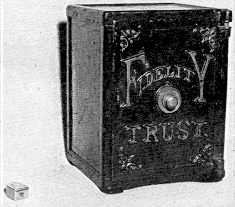
HERE ARE THE LARGEST AND SMALLEST banks in
Johannsen's collection.
At the left is the tiny Sunday school bank, which holds ten dimes. The Safe
bank, a cubic foot in size, opens with a combination lock.
The next step was to remove from the wax model all the parts which were intended to be
movable - the arms of the politician, the leg of the kicking mule, the jaw of a man, and
often the eyes of the figure. A new model of each of these parts then had to be made with
an end or joint attached to it. All the separate pieces were then sent to a foundry to be
cast in bronze.
When the bronze pieces came back, some of them were very rough and had to be filed and
chased to make them fit into each other. The pieces of the assembled bronze model had to
fit together perfectly and move easily, or the cast iron banks then made from the model
would not work properly.
It is easy to see why a manufacturer might hesitate to go through this lengthy and
expensive process if he had any doubt as to the salability of the bank.
One of the banks in Johannsen's collection was made for him from the original patent
papers. It is a miniature wooden bureau, the top drawer of which accepts the coins. The
drawer is pushed in, and when it is withdrawn again, the coin has disappeared into the
bank's secret compartment.
ALTHOUGH JOHANNSEN considers the mechanical banks the stars of his collection, there is an
even brighter star - his favorite bank. It is a German "Mission Bank," with
kneeling angel who nods her head in thanks when a coin is dropped into the slot of a
golden plate on the grassy hill on which she kneels.
"I believe I am the only collector in the country who owns such a bank," he
says. "I wouldn't put a price on it. It is priceless."
The rarity of the bank is not the factor that endears it to Johannsen. Actually, it
personifies childhood memories of his native Germany. The little Lutheran church to which
he belonged had a similar bank - with a little Negro boy instead of an angel - to
encourage children to give money for foreign mission work.
When he began to collect banks, he searched for the bank of his childhood, but in vain. He
did find the angel mission bank in an antique shop, and the dealer presented it to him as
a gift.
"But I still wanted the Negro foreign-mission bank," he says, "and when we
were in Germany in 1952, my wife and I went to the little church to see if it was still
there."
"It was there, all right," puts in Mrs. Johannsen, "but they wouldn't sell
it. The children were still faithfully putting their pennies into it every week, and the
pastor said the church just couldn't afford to part with it."
Johannsen still hasn't given up hope of someday obtaining such a bank, however. It is one
of the fascinating peculiarities of collecting that you never know when an exciting find
is just around the next corner. It gives the collextor something to look eagerly forward
to each day. It keeps the spring in a man's step and youth in his eyes.
THERE ARE a number of sources of banks which Johannsen checks regularly in order to add to
his collection. First, of course, he visits antique shops wherever he goes. Whether or not
a shop has any banks for sale at the time of his visit, he leaves his name, address, and
telephone number, with the request that he be notified when banks - mechanical or still -
come into the shop.
Another source of banks are auctions, which often produce an item considered of little
value by the owner or auctioneer, and which can be purchased at a low price.
A word here about the term "value." The value of a bank, like most collector's
items, is generally only what another collector is willing to pay for it. That is why
Johannsen advises specializing in banks alone, in order to familiarize yourself with the
amount a bank is worth to a collector.
Value depends on a bank's condition, scarcity, and mechanical action. There are also small
differences between apparently similar banks which can mean large differences in the
bank's worth. Different types of coin traps, different wording on the banks, different
manufacturers - all are variations which a collector should understand in order to
estimate accurately the value of his banks.
"Although I've made profitable purchases of most of my banks," says Johannsen,
"I was stung a few times at first, because I did not know the value of a bank, or
because I had set my mind on having it, and overpaid.
"But I have also, I regret to say, passed up opportunities to buy because I had my
mind set on a price not to be exceeded. If I had at that time been more familiar with
prices, I would have known that even some seemingly high prices were actually less than
the value of the bank."
Johannsen relates a classic example of a collector obtaining a number of banks at less
than their value. "My collector friend, who lives in Indiana, started collecting in
1937, as I did," says Johannsen, "and had a real stroke of luck in 1941 that put
him on the map in a hurry. Driving through the eastern states, he stumbled on to an old
man who sold him 175 different mechanical banks in perfect condition for $1,245, an
average of $7.11 per bank. His ultimate profit on the transaction was at least
tenfold!"
FORTUNATELY, THE person who wishes to begin collecting banks can now refer to two
excellent books, available in many large city libraries, which give him information it
took Johannsen years to acquire. The first is "Old Mechanical Banks," by Ina
Hayward Bellows, published by the Lightner Publishing Company of Chicago in 1940. This
book lists and describes a great many banks, and gives their valuation as it was in 1940.
Most of the banks have risen in value since that time, however.
The second reference book is "A Handbook of Old Mechanical Penny Banks," by John
D. Meyer of Tyrone, Pennsylvania, published in 1947. This book has photographs and
descriptions of all known mechanical banks, plus some indication of their worth, such as
"Very Rare" or "Common." Because of the rising value of the banks,
Meyer does not attempt to put a precise valuation on each.
A small booklet which was recently published is probably the most helpful of all, because
it gives the value of each bank as judged by each of the several experts in the field, and
lets the bank collector judge for himself. It is entitled "Old Penny Mechanical Banks
Price List, Including Gradations of Prominent Authors." This booklet, which is
available at $1 from Henry W. Miller, 29 Lincrest Street, Hicksville, Long Island, New
York, does not contain pictures or descriptions of the banks, but only the names.
EVEN BECOMING an expert is not always a safeguard for the too-avid collector. Johannsen
has a "football bank," which he keeps around to remind him of what can happen
when he tries too hard to get a bargain.
One day, a couple of years ago, one of his daughters went to a rummage sale - another
prolific source of banks - to see if there were any items of interest. She came back to
say that there were two banks - one of them a football player.
"I had wanted a football player for a long time," recalls Johannsen, "so I
rushed right over to the church and bought both banks. I paid quite a bit for the football
player, but nowhere near the actual sale value of such a bank. I came home elated with my
bargain.
"I showed the bank to my wife -" he paused to take the bank off a shelf, "-
it's this little football player who kicks a tiny ball attached to a string when a lever
is pushed. My wife looked at is a minute, and then asked, 'But where do you put the
penny?'
"And do you know," he chuckled ruefully, "there was no slot for a penny! It
wasn't a bank after all - just a mechanical toy!"
Johannsen subsequently altered the football player so that it became a bank. He does not
consider it a part of his authentic collection and it could never be sold as a bank - but
he feels that having it around keeps him humble.
THE SALVATION ARMY and Goodwill stores found in most large cities are also good sources of
banks. These organizations are constantly receiving years' accumulation of junk from
people's attics - and all kinds of old banks turn up frequently. If it isn't convenient
for the collector to visit the stores frequently, he might ask one of the salespeople to
notify him when a bank comes in.
"This is such a good way of finding the really rare banks," says Johannsen,
"that a doctor friend of mine, who is now dead, used to go to the Milwaukee Goodwill
store near his office three times every day. He found some very good banks that way."
For Johannsen, who is not given to superlatives, "very good" is the top
classification in his collection.
Buying banks at prices lower than their value makes a collection potentially profitable,
if a collector should ever decide to sell. It just happens that Johannsen does not intend
to sell any of his collection of 786 all different banks at any price, but he does have
many duplicates, which he sells to other collectors.
"I buy almost any bank I come across," he says, "because I know all the
collectors in Milwaukee, and can usually sell the duplicates."
Since Johannsen is not out for a profit, he sells the banks to collectors at the price he
paid for them - sharing with these collectors the opportunity to add to their collections
at reasonable prices. There are many bank collectors, however, who do conduct such re-sale
of banks at a high profit.
Selling at a profit is not the only way to earn dividends on an investment, however.
Merely holding the banks for a few years increases their value. One bank which sold for
$1.50 several years ago when it was new is now worth $16.00. Even the very modern banks -
such as the "Bomb Hitler" and "Lick the Axis" banks of World War II -
are fast becoming collector's items, and will some day be worth many times their original
cost. It is the same with the toy banks given out by large banks and building-and-loan
companies to their customers.
ONE SECTION of Johannsen's bank-filled upstairs room is devoted to the tin, plastic, and
glass banks his grandchildren give him on birthdays and at Christmas, These have only
sentimental value at present, but they may some day be worth a great deal.
Among the many unusual banks on Johannsen's shelves are two coconut banks, intricately
carved and polished - one worth $50, the other worth about $40. The difference lies in the
fact that the coin trap of one of the banks was missing when he found it in a Chicago
antique shop. You wouldn't know which one, however, if Johannsen didn't tell you. In order
to complete the bank with the missing part, Johannsen bought a coconut and painstakingly
carved and polished a coin trap to match the rest of the bank.
"It took me many long hours to complete that little coin trap," he says,
"so you can imagine how long it must have taken to carve the whole coconut."
One of the most valuable banks in his collection is the Light of Asia, a cast iron
elephant who nods his trunk when a coin is inserted in his back. This is worth $150 - much
more than Johannsen paid for it.
A bank of which Mr. J. is particularly proud is the Southern Comfort bank, put out by a
whisky manufacturer, The president of the company, who happened to be a toy bank collector
himself, issued just 1,000 of these silver-plated banks, individually numbered, and
offered them privately at a nominal fee to known collectors. Johannsen has a notarized
affidavit showing that he was issued bank number thirty-one.
An enameled version of the Southern Comfort bank was later offered to the general public
through advertisements in hobby magazines, but these are worth only a fraction as much as
the silver-plated originals.
MR. JOHANNSEN regards advertisements in hobby and antique magazines as prime sources of
items for a bank collection. The collector can run his own advertisements in the
"Wanted" columns of the magazines - or he can check the "For Sale"
advertisements of the dealers.
By watching the advertisements he gets to know the names of other collectors throughout
the country, and mutually profitable trades can often be worked out.
Johannsen once traded thirty-two surplus mechanical banks for just three from another
collector - and felt that it was a fair bargain because of the quality of the three banks.
Even the least valuable of the three, a Pelican bank, is worth $95, and the others worth
more.
Johannsen keeps an account book in which he records the price and the source of each new
bank he gets for his collection, together with manufacturing and patent data.
After a collector has accumulated a few items, he will often want to display them at
school or club hobby shows. This, according to Johannsen, is another way of building up a
collection. No matter how small the hobby show, someone invariably tells him, "Why,
I've got an old bank somewhere around the house. I'll sell (or, in rare cases, 'give') it
to you."
Since hobby shows are often reported in local newspapers, there is a good chance that
individual exhibitors will receive special attention in feature articles. Johannsen has
been written up several times in both Milwaukee papers, and each article was picked up by
the press services and reprinted in newspapers in other large cities.
Each newspaper article brings him information about other banks which are being offered
for sale.
Johannsen's appearances at hobby shows have also led to publicity on television shows. The
antics of a few mechanical banks would provide enough action to keep a TV show lively,
even if Johannsen weren't the enthusiastic speaker he is. Each such appearance brings
Johannsen's name before the public so that people automatically think of him when they run
across a bank.
"These are the contacts which make it possible for a collector to get at the banks
stored away in people's attics," says Johannsen. "The hardest thing for a
collector is to gain admittance to private homes. You can't just go around ringing the
doorbells of old homes asking if people have any banks in the attic. They'd think you were
crazy! But if you become well known in your community through publicity, people will come
to you instead."
A BANK collection need not be confined to the banks of the last century, which was the
heyday of the mechanical variety. The really avid collector can go much farther back than
that and build up an extremely valuable collection.
Saving money dates back to ancient Greece, where pottery urns were used. Pottery and
porcelain still banks were also known in Europe at a very early date. The first known
mechanical bank is an alms box of China's Han dynasty, which was just before the Christian
era. This bank is in the Metropolitan Museum of Art in New York.
Imagine how exciting it would be to obtain one of these museum pieces for one's
collection!
Penny banks first appeared in America in 1793, along with the first big copper pennies.
These banks were usually of pottery, glass, or tin, and often held tea or honey before
they were emptied to be used as banks.
Johannsen has a porcelain reproduction of a log cabin, with an opening in the chimney
barely large enough for the insertion of a coin. This originally was a tea container, and
the housewife who wanted to use the tea had to shake it out, a little at a time, through
the chimney!
When this type of bank was filled with coins, the only way to remove them was also through
the chimney, one by one - unless the owner was in a hurry, in which case he could simply
take a hammer to it.
Some of the glass banks of this period are collector's items in another field - that of
glassware. Johannsen has, among others, a glass reproduction of Independence Hall in
Philadelphia, made in 1875, and molded in three parts, instead of the more common two
parts. For this reason, the bank is doubly valuable.
BEN FRANKLIN, with his "Poor Richard's Almanac," greatly influenced the American
people so that saving became a national habit. Nowhere else in the world was the toy bank
as popular as it was in America.
Americans had a reputation abroad for "squeezing the eagle until it screamed."
It might be noted, however, that European manufacturers tried their best to profit from
America's thrift by exporting a great many tin banks for sale on the American market.
After the Civil War, however, when foundries stopped making war material and looked for
new fields, the more fragile tin banks were swept off the market by the appearance of the
sturdier cast-iron banks, which could be made in such varied shapes.
Somewhere around the turn of the century, it became common for bankers - real bankers,
that is - to collect toy banks. Some of the most fabulous collections in the world were
amassed by these men. To this day, the best collections are owned by bankers, such as
Andrew Emerine, president of the First National Bank of Fostoria, Ohio.
Industrialists too, such as Ford and Chrysler, were given to the collection of banks.
"Those men could have all the best banks if they wanted them," Johannsen says a
bit wistfully, "because they didn't have to consider price."
There are banks still in existence today, perhaps in somebody's attic, which are valued at
$1,000 or more. The dream of every bank collector who is not a millionaire is to find one
of these banks for sale at a reasonable price.
In the meantime most of them, like Johannses, are content to collect the exciting
mechanical and still banks that tell the history of our nation. The story of banks is the
story of free enterprise, the rags to riches, of Horatio Alger - of the freedom to improve
one's status that is characteristic of America.
EMERINE COLLECTION
ON EXHIBIT
The First National Bank of Fostoria, Ohio, recently placed on
exhibition an outstanding Coin Bank Collection representing the kind of banks
youngsters treasured eighty years ago.
Most of the banks are made of cast iron, and date from 1870 to 1900. They were
the principal produce of several eastern foundries, Stevens Foundry at Cromwell,
Conn., being the largest producer, according to a bulletin on the Collection
published by The First National Bank, and sent out by Mr. and Mrs. Andrew
Emerine of Fostoria.
Many characters and subjects were represented in these banks, including
biblical, historical, comical, sports, also Chinamen, Indians, Irishmen, Red
Riding Hood, William Tell, Christopher Columbus, Uncle Sam, Teddy Roosevelt,
John Bull, Jonah and the Whale, and, among the animals, elephants, frogs, and
pelicans.
Emerine especially prizes the Freedman Bank made at Bridgeport, Conn. Other
interesting ones include The Bread Winner Bank, the Merry-Go-Round, the Carnival
Bank, The Harlequin Bank, and Shoot the Chute with Buster Brown and Tigue.
English Banks include John Bull Money Box and Wimbledon obtained at Norwich,
England.
Besides banks, the Museum has a display of Automatona, including musical dolls,
acrobats, and walking figures. A boy with a pewter dish containing soap suds
dips his pipe, puts it to his lips, and blows bubbles. U. S. Grant seated in a
chair smokes & turns his head and puffs out smoke. A woman is busy churning.
A lady works at a wash-tub over a washboard . A bird sings in a gilded cage.
Rare sand toys also are shown. A toy turning upside down trickles sand down on a
cardboard wheel, action is transmitted to figures, and banjo and violin players
go into action, so do the dancer and dog.
Thirty years ago many of these items were rather readily available to
collectors, but now they have become very rare and the price has correspondingly
raised, as is typical of many a Collector's item.
MCCALLS - May 1953
COLLECT SMALL ANTIQUES
Mechanical banks
by Katharine M. McClinton
Author of Antique Collecting for Everyone
TIN and cast-iron children's coin banks were
popular from about 1860 to 1910. They are still made.
Mechanical banks work when a coin is inserted in a slot. The most popular ones
are animals including dogs, cats, elephants, frogs, owls, turtles, lions and
alligators. Some are replicas of historical objects. Others are miniatures of
Punch and Judy, Little Red Riding Hood, Santa Claus, Jonah and the Whale and the
Old Woman in the Shoe.
The most commonly seen today are the Harlequin and Columbine, Speaking Dog,
Kicking Mule, William Tell and Humpty Dumpty. The rarest include the British
Lion, Girl in Victorian Chair, Battleship Masachussetts, Ferris Wheel, Bowling
Alley and Fortune Teller. Most are painted or enameled.
